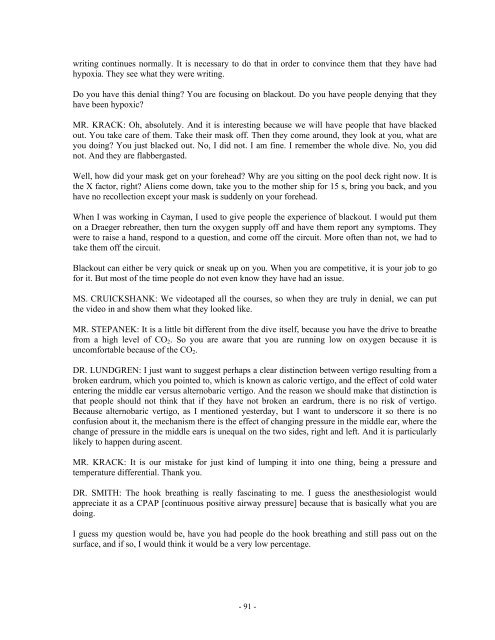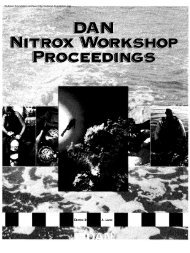BREATH-HOLD DIVING Workshop Proceedings - Divers Alert Network
BREATH-HOLD DIVING Workshop Proceedings - Divers Alert Network
BREATH-HOLD DIVING Workshop Proceedings - Divers Alert Network
Create successful ePaper yourself
Turn your PDF publications into a flip-book with our unique Google optimized e-Paper software.
writing continues normally. It is necessary to do that in order to convince them that they have had<br />
hypoxia. They see what they were writing.<br />
Do you have this denial thing? You are focusing on blackout. Do you have people denying that they<br />
have been hypoxic?<br />
MR. KRACK: Oh, absolutely. And it is interesting because we will have people that have blacked<br />
out. You take care of them. Take their mask off. Then they come around, they look at you, what are<br />
you doing? You just blacked out. No, I did not. I am fine. I remember the whole dive. No, you did<br />
not. And they are flabbergasted.<br />
Well, how did your mask get on your forehead? Why are you sitting on the pool deck right now. It is<br />
the X factor, right? Aliens come down, take you to the mother ship for 15 s, bring you back, and you<br />
have no recollection except your mask is suddenly on your forehead.<br />
When I was working in Cayman, I used to give people the experience of blackout. I would put them<br />
on a Draeger rebreather, then turn the oxygen supply off and have them report any symptoms. They<br />
were to raise a hand, respond to a question, and come off the circuit. More often than not, we had to<br />
take them off the circuit.<br />
Blackout can either be very quick or sneak up on you. When you are competitive, it is your job to go<br />
for it. But most of the time people do not even know they have had an issue.<br />
MS. CRUICKSHANK: We videotaped all the courses, so when they are truly in denial, we can put<br />
the video in and show them what they looked like.<br />
MR. STEPANEK: It is a little bit different from the dive itself, because you have the drive to breathe<br />
from a high level of CO 2 . So you are aware that you are running low on oxygen because it is<br />
uncomfortable because of the CO 2 .<br />
DR. LUNDGREN: I just want to suggest perhaps a clear distinction between vertigo resulting from a<br />
broken eardrum, which you pointed to, which is known as caloric vertigo, and the effect of cold water<br />
entering the middle ear versus alternobaric vertigo. And the reason we should make that distinction is<br />
that people should not think that if they have not broken an eardrum, there is no risk of vertigo.<br />
Because alternobaric vertigo, as I mentioned yesterday, but I want to underscore it so there is no<br />
confusion about it, the mechanism there is the effect of changing pressure in the middle ear, where the<br />
change of pressure in the middle ears is unequal on the two sides, right and left. And it is particularly<br />
likely to happen during ascent.<br />
MR. KRACK: It is our mistake for just kind of lumping it into one thing, being a pressure and<br />
temperature differential. Thank you.<br />
DR. SMITH: The hook breathing is really fascinating to me. I guess the anesthesiologist would<br />
appreciate it as a CPAP [continuous positive airway pressure] because that is basically what you are<br />
doing.<br />
I guess my question would be, have you had people do the hook breathing and still pass out on the<br />
surface, and if so, I would think it would be a very low percentage.<br />
- 91 -
















